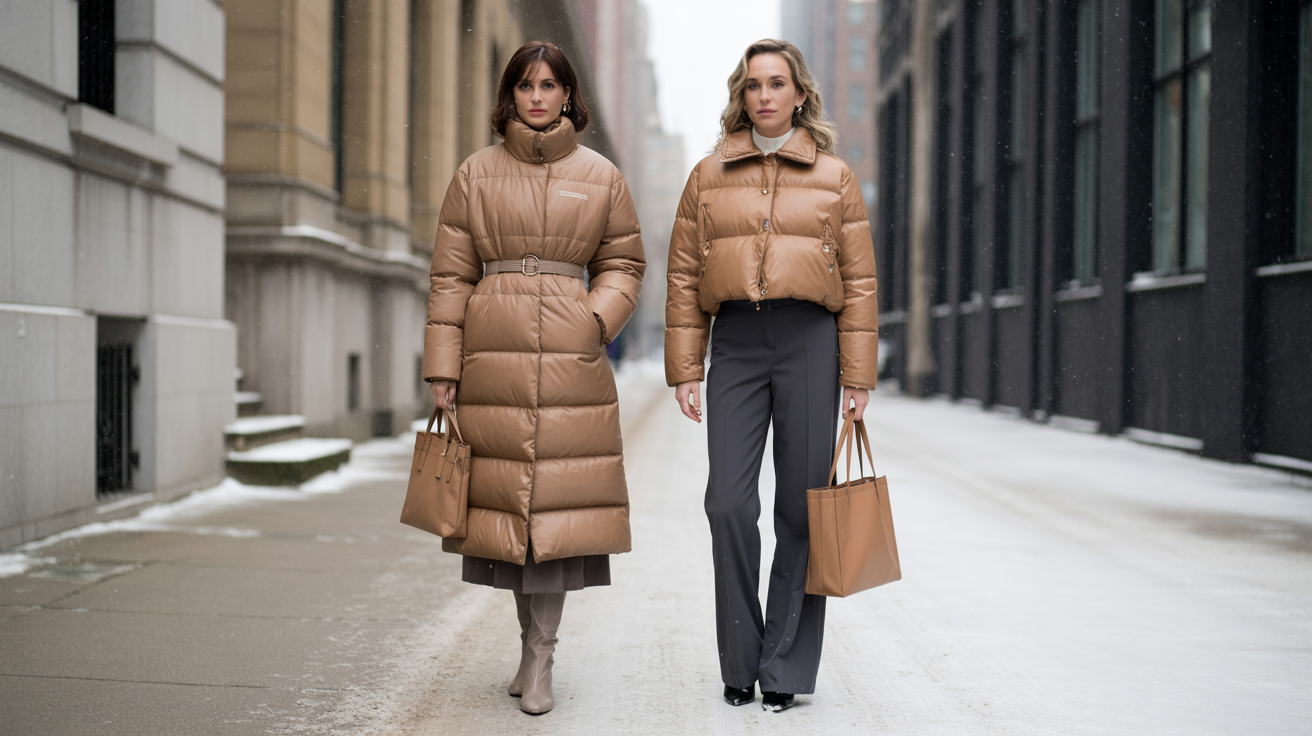A puffer coat doesn’t have to read “snow day.” With the right proportions, textures, and pairings, it can look as sharp as a wool overcoat—only warmer. This guide gives you seven outfit formulas that deliver structure, elegance, and ease, without the dreaded marshmallow effect. Expect quick equations, fit notes, climate swaps, and smart style logic you can apply to any puffer in your closet.
What you’ll get: a clear take on the puffer-but-polished aesthetic, temperature-aware styling, and a bonus interactive planner to build your own looks.
Before You Style: The Polished Puffer Principles
The difference between “bundled” and beautifully composed is rarely the coat itself—it’s the styling choices around it.
- Proportion is everything. Anchor volume with tailored lines. When the puffer is roomy, reach for structured trousers, sleek boots, or a defined waist.
- Texture makes it luxe. Matte shells read more elevated than glassy nylon. Pair the coat with flannel, cashmere, tweed, leather, or ribbed knits for depth.
- Tonal = instant polish. A monochrome or near-monochrome palette looks intentional and elongates your silhouette.
- Hardware and quilting count. Subtle zips, minimal toggles, and finer baffle quilting feel sharper. Oversized baffles skew sport.
- Finish the edges. Clean hems, pressed pants, gleaming leather, and a structured bag can transform even the puffiest outer layer.
Keep those principles in mind as you explore the seven formulas below.
A 60-Second Buyer’s Mini-Guide (So Your Coat Helps, Not Hurts)
You don’t need to be technical to dress well—but a little knowledge helps.
- Fill power (down): Higher numbers = more warmth per ounce. 600–700 = everyday winter; 700–850+ = serious cold.
- Down vs. synthetic: Down is light and compressible; synthetic performs better in wet conditions and is easier to wash.
- Shell fabric: Matte or textured shells photograph and style more elegantly than high-gloss. Look for recycled nylon/poly with durable feel.
- Weatherproofing: DWR (durable water repellent) is a surface treatment; laminated membranes offer more robust water/wind protection.
- Length & quilting scale: Cropped energizes wide-leg or high-rise bottoms; hip-length is the all-rounder; longline pairs beautifully with narrow skirts or straight trousers. Smaller quilting looks neater.
The Seven Formulas (No Bulk, All Style)
Each look includes a Formula, Why It Works, Fit & Proportion Notes, Climate Swaps, and Styling Moves to make it your own.
1) Cropped Puffer + Wide-Leg Trouser + Pointed Boot
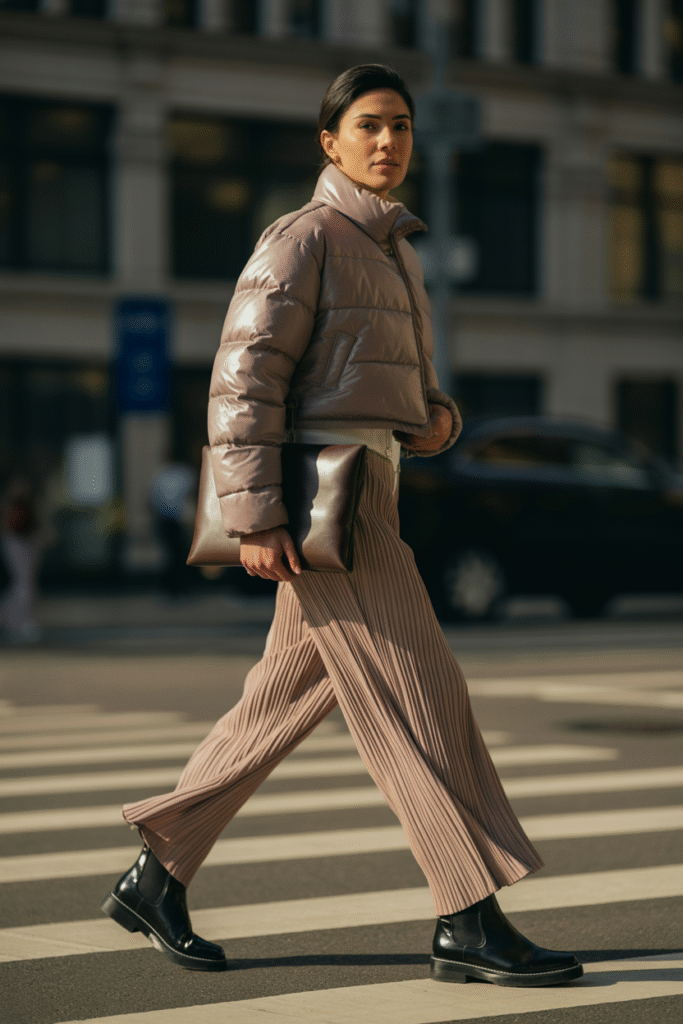
Formula: Cropped puffer (matte, neat quilting) + high-waist wide-leg trousers (pressed crease) + pointed or almond-toe ankle boot + structured leather bag.
Why it works: Cropped length defines the waist and lets the trouser drape take center stage—volume on bottom, precision on top. The pointed boot sharpens the line.
Fit & Proportion Notes:
- Petite: Choose a crop that hits at or slightly above the true waist; hem trousers to skim the vamp of your boots.
- Tall: Add a belt to break up length if you feel “column-like.”
- Curvy/plus: Look for a gently A-line crop (not tight at the ribcage) and trousers with front pleats for room through hip and thigh.
- Menswear/gender-neutral: Swap pointed boots for sleek Chelsea or plain-toe lace-ups.
Climate Swaps:
- Mild (11–15°C): Lightly filled cropped puffer; unlined wool trousers.
- Cool (6–10°C): Mid-fill puffer with merino base top; leather boots with thin sock.
- Cold (≤5°C): Add heattech/thermal under trousers and a cashmere turtleneck.
Styling Moves: Keep the palette tonal (charcoal/black/navy) for an elongated look. Add fine jewelry or a sleek leather belt for polish.
2) Belted Longline Puffer + Midi Skirt + Tall Boot
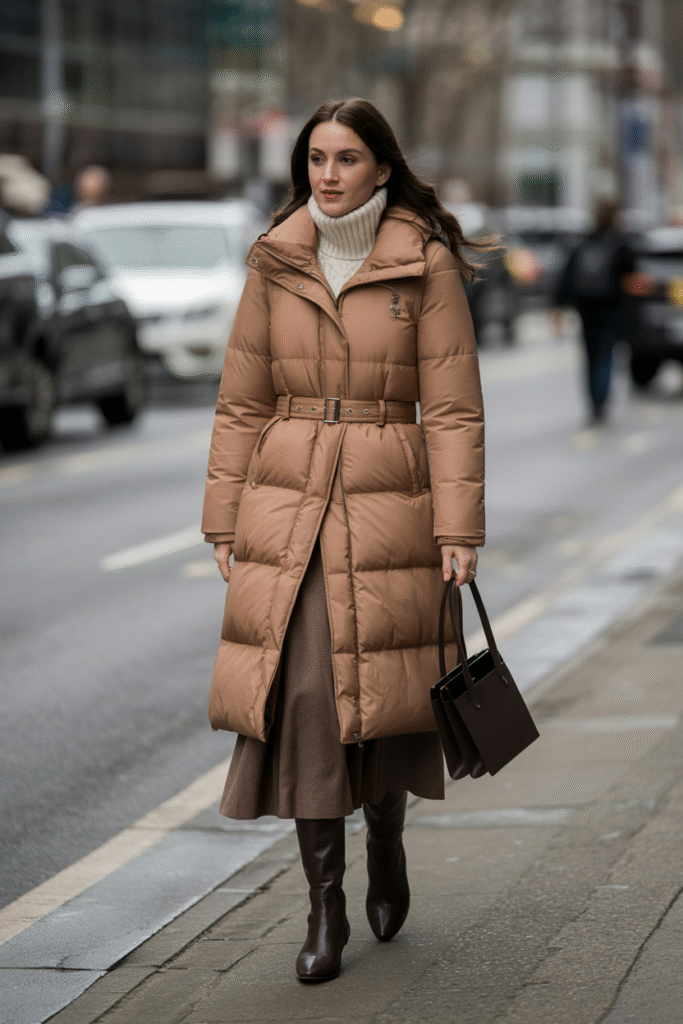
Formula: Longline puffer with a belt (self-tie or leather) + midi skirt (pencil or soft A-line) + knee-high boots + structured top-handle.
Why it works: A clean vertical line from shoulder to hem plus a defined waist reads tailored. The midi length echoes the coat’s sweep.
Fit & Proportion Notes:
- Petite: Opt for a narrow-quilt longline that hits mid-calf; keep the boot shaft close to the leg.
- Tall: A longer hem (low-calf) looks elegant; try a thicker belt for presence.
- Curvy/plus: A single-breasted front and soft belt avoid bulk; choose a skirt with movement (kick pleat or bias).
- Menswear/gender-neutral: Swap midi for straight trousers; belt the puffer over a fine-gauge roll-neck.
Climate Swaps:
- Mild: Unlined or thin-fill coat; leather midi.
- Cool: Wool midi or ribbed knit skirt + lined boot.
- Cold: Fleece-lined tights; add a thin down vest under the coat.
Styling Moves: Choose matte shell and minimal hardware. Tie the belt slightly off-center for a softer, luxe vibe.
3) Matte Hip-Length Puffer + Pleated Trouser + Loafer
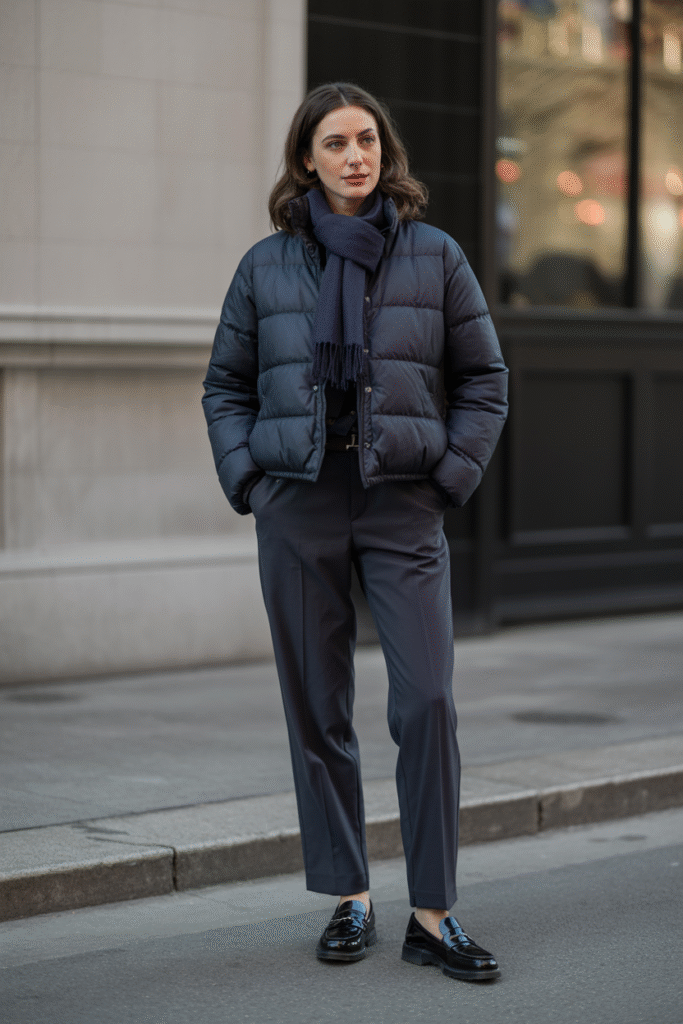
Formula: Hip-length puffer (matte, minimal shine) + single-pleat tailored trousers + penny or lug-soled loafer + cashmere scarf.
Why it works: The hip length is the most versatile, and the pleat introduces room without slouch. Loafers add an old-school, office-capable finish.
Fit & Proportion Notes:
- Petite: Keep hem just below hip bone; avoid puffers that end mid-thigh.
- Tall: Slightly longer hem balances long legs.
- Curvy/plus: A gentle taper or straight leg with a front crease is flattering; avoid extra-chunky soles if you want a cleaner line.
- Menswear/gender-neutral: Add a merino polo or oxford under the puffer.
Climate Swaps:
- Mild: Cotton-wool blend trousers.
- Cool: Flannel with micro-fleece base layer.
- Cold: Thermal long johns; swap loafers for waterproof derbies.
Styling Moves: Lean monochrome (all navy, all camel, all charcoal). Finish with a structured brief or tote.
4) Tailored Layering: Puffer Over Blazer + Straight Denim + Chelsea Boots
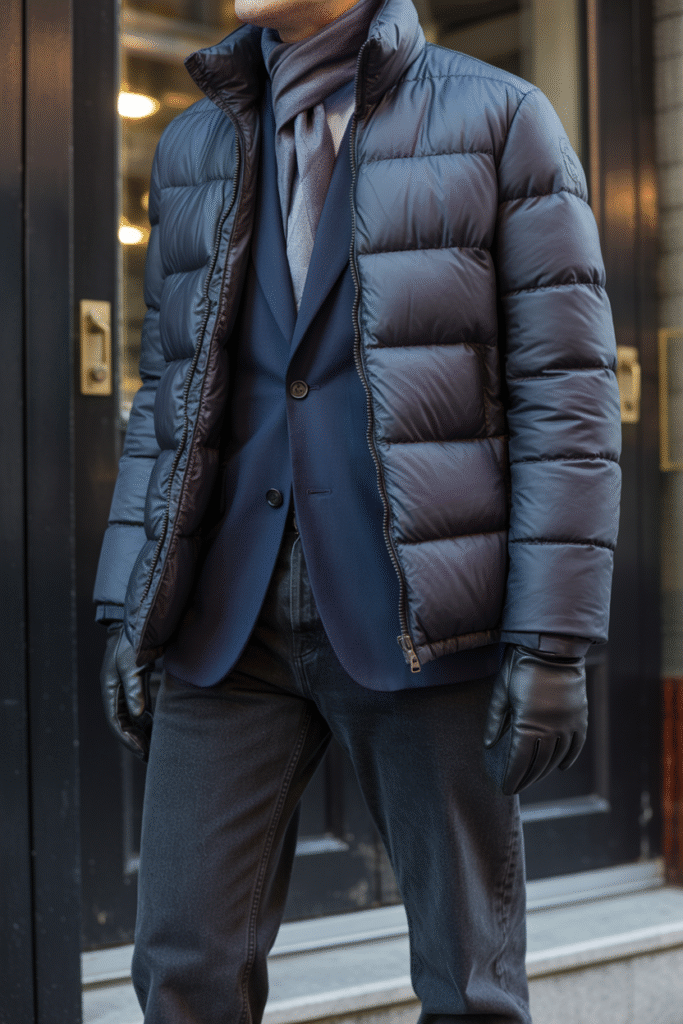
Formula: Slim, lightly filled puffer worn over a blazer (or tailored jacket) + straight-leg dark denim + Chelsea boots + leather gloves.
Why it works: You layer tailoring under tech—a mix that reads modern and intentional. The blazer’s edges give the puffer context and frame the torso.
Fit & Proportion Notes:
- Ensure the puffer has raglan sleeves or enough room at the armhole so the blazer doesn’t bunch.
- Petite: Cropped blazer + slightly shorter puffer.
- Tall: Try a longer blazer hem under a hip-length puffer for cool overlap.
- Curvy/plus: Choose a blazer with soft structure and a puffer with two-way zip to adjust comfort when seated.
Climate Swaps:
- Mild: Unlined blazer; light puffer vest over it instead of a full coat.
- Cool: Mid-fill puffer with merino roll-neck under blazer.
- Cold: Add a thin quilted liner between blazer and coat.
Styling Moves: Keep denim clean and dark (no distressing). Add a silk scarf tucked into the blazer neckline for polish.
5) Monochrome Minimalist: Tonal Puffer Set + Sleek Sneaker (or Dress Boot)
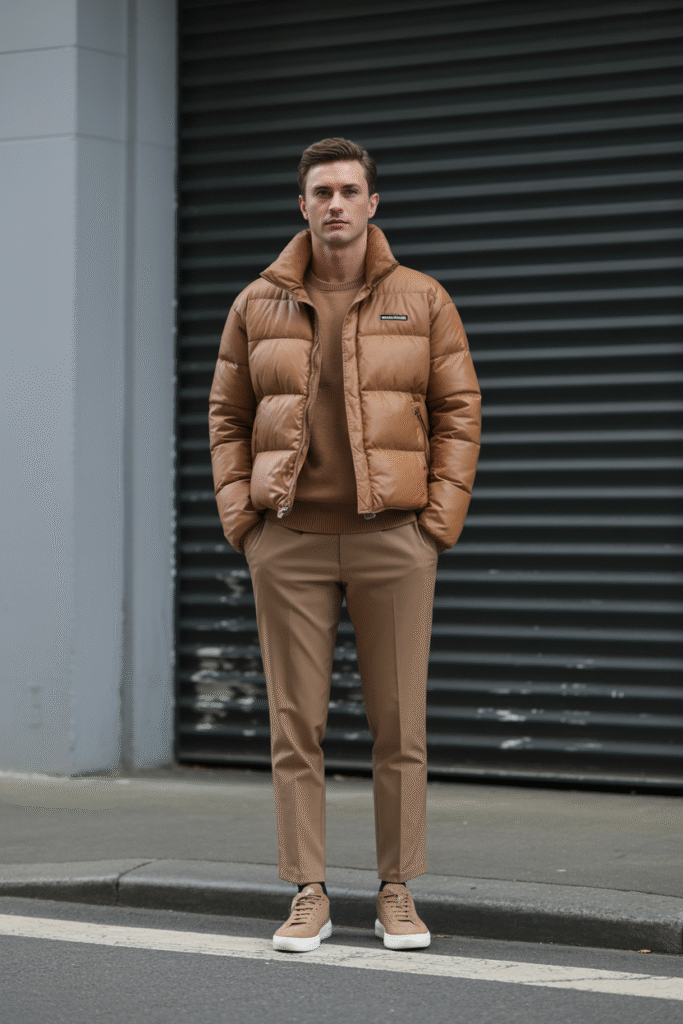
Formula: Tonal puffer + matching or near-matching knit + tailored joggers/straight trousers in same family + sleek leather sneaker or dress boot.
Why it works: Head-to-toe tone elongates and simplifies. Even casual silhouettes look considered when the palette is unified.
Fit & Proportion Notes:
- Keep the puffer silhouette neat—avoid oversized baffles and bulky collars.
- Petite: Narrow quilting + tapered trouser.
- Tall: You can play with longer hems and high-neck knits.
- Curvy/plus: Choose a drapey knit that glides; trousers with elastic back waist can fit beautifully while staying sleek.
Climate Swaps:
- Mild: Cotton-cashmere knit; low-fill puffer.
- Cool: Merino or cashmere knit; mid-fill puffer.
- Cold: Fleece tights under trousers; add a beanie in the same tone.
Styling Moves: Think all-ivory, all-camel, all-charcoal, or all-navy. Minimal jewelry, matte leather, tidy hair—quiet-luxury energy.
6) Knit Dress + Streamlined Puffer + Knee-High or Sock Boot
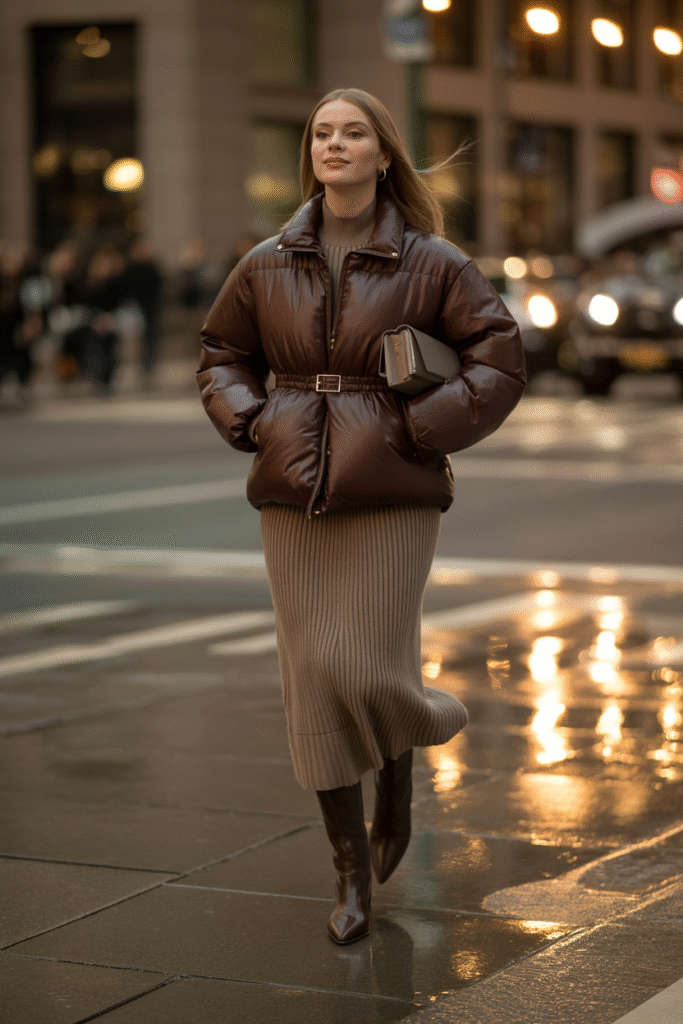
Formula: Streamlined puffer (straight or gently belted) + ribbed knit dress (midi) + knee-high boot or sock boot + structured clutch or compact tote.
Why it works: A fluid column under a simple coat reads sophisticated. The puffer becomes a warm shell rather than the main event.
Fit & Proportion Notes:
- Petite: Choose a midi that hits mid-calf; too long shortens the leg.
- Tall: Consider a slit for movement and line.
- Curvy/plus: Focus on vertical ribbing and dense knits that skim, not cling; a V- or funnel-neck can balance shoulders and bust.
- Menswear/gender-neutral: Swap dress for fine-gauge turtleneck + tailored skirt over tights or soft pleated trousers.
Climate Swaps:
- Mild: Lightweight rib knit + low-fill puffer.
- Cool: Wool blend dress + lined boot.
- Cold: Thermal slip under dress + longline puffer.
Styling Moves: Keep accessories sleek—no large logos, minimal hardware, tone-on-tone scarves.
7) Rain-Polished: Water-Resistant Puffer + Merino Layers + Umbrella
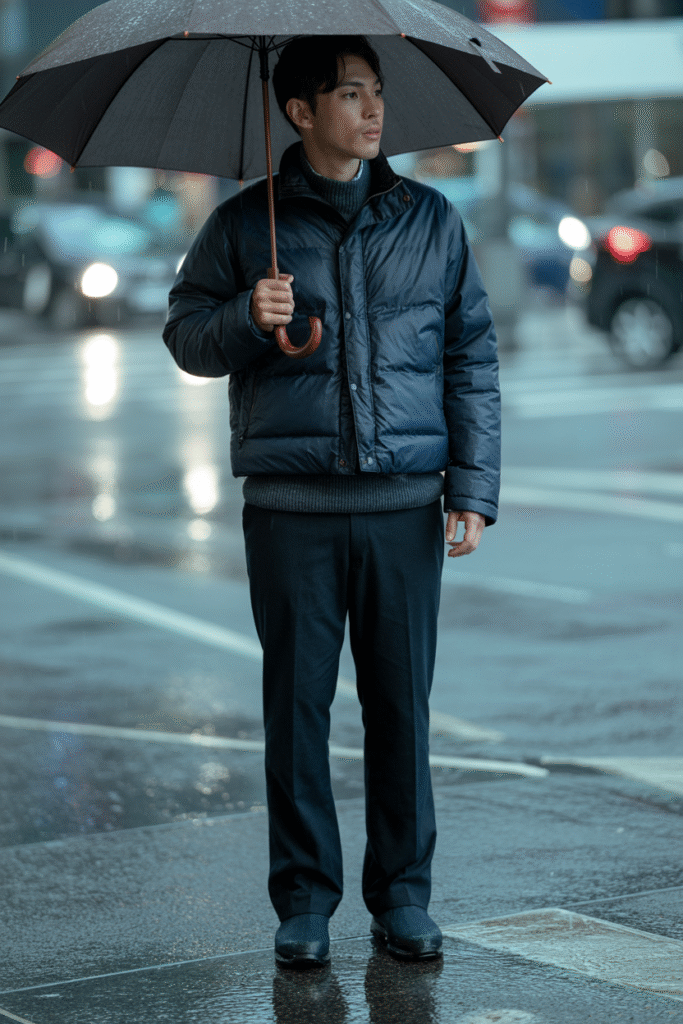
Formula: Water-resistant puffer (matte if possible) + merino crew or roll-neck + straight wool trousers or dark denim + waterproof boots + solid umbrella.
Why it works: Practicality can still look city-smart. The clean lines of tailored bottoms and solid footwear turn a weather day into architectural minimalism.
Fit & Proportion Notes:
- Look for sealed seams or robust DWR if your climate is truly wet.
- Petite: Keep hems above the shoe to avoid splash lines.
- Tall: Try a slightly longer puffer for balance.
- Curvy/plus: A two-way zipper helps with comfort and mobility.
Climate Swaps:
- Mild: Lightweight puffer + trench-length umbrella.
- Cool: Add thin fleece under merino.
- Cold: Switch to insulated waterproof boots and line gloves.
Styling Moves: Neutral palette—navy, stone, black, charcoal—with a wood-handled umbrella for a quiet, refined touch.
Polished Puffer Outfit Builder
Select your options above to generate a polished look.
Care, Storage & Longevity (Because Polished Starts with Well-Kept)
You can style a puffer beautifully—and ruin the effect with linty fabric or flat insulation. A quick routine keeps the loft, line, and luster.
- Washing: Check the label. Most synthetic-fill puffers wash easily; many down puffers can go in a front-loader on gentle with down-safe detergent.
- Drying: Low heat, clean tennis balls in the dryer to re-loft the fill. Pause occasionally to break up clumps by hand.
- Water repellency: Refresh DWR with a spray after several washes or heavy rain seasons.
- Storage: Off-season, store zipped and hung on a wide hanger or loosely folded—never vacuum-seal down.
- Repairs: Tiny shell nicks? A clear repair patch or tonal tape prevents leaks and looks tidy.
These small habits keep your coat crisp and intentional—the key to puffer but polished.
Sustainability Notes (Feel Good While You Look Sharp)
- Responsible fill: Look for RDS (Responsible Down Standard) or recycled down; for synthetics, recycled polyester insulation reduces waste.
- Durable shells: Tougher weaves last longer; matte recycled nylon often wears better than super shiny, ultra-thin fabrics.
- Repair first: Patch, re-proof, replace a zipper pull—small fixes extend a coat’s life.
- Buy for the role: If you live in a rainy city, prioritize water resistance; if it’s dry and frigid, reach for higher fill power. The right choice means less buying, more wearing.
Quick Reference: What to Pair, When
- Office: Belted longline or hip-length matte with pressed trousers or midi skirt and polished boots.
- Evening: Longline, streamlined, with a knit dress or silky separates, minimal jewelry, and a small bag.
- Weekend city: Hip-length with pleats or straight denim, loafers or sleek sneakers, tonal layers.
- Rain: Water-resistant puffer + straight hems, waterproof leather shoes, structured umbrella.
- Snow & wind: Insulated longline + thermal base, lug soles, beanie and gloves in matching neutrals.
FAQ
How do I avoid looking bulky in a puffer?
Balance the silhouette. Pair a roomy coat with tailored bottoms and structured footwear. Choose matte shells, smaller baffles, and two-way zips to adjust the shape.
Can a puffer work for the office?
Yes—choose hip-length or longline with minimal hardware. Add pressed trousers, knee-high or ankle boots, and a structured tote. Stick to a neutral palette for the most polish.
Is cropped or longline more versatile?
Hip-length is the chameleon. Cropped is great with high-rise or wide-leg trousers, while longline shines over skirts and straight pants—particularly in wind and snow.
Down or synthetic—what’s better?
For dry cold, down is warmer for its weight. For wet climates or easy care, synthetic wins. If you pick down, mind fill power and keep it dry.
How should a puffer fit?
You should comfortably layer a knit or blazer underneath without pulling. Sleeves should cover your wrist even when you lift your arms. The hem should not collapse into your pockets—clean edges = clean look.
What shoes keep things polished?
Chelsea boots, heeled ankle boots, knee-high boots, loafers, and sleek leather sneakers. Keep soles slim or neatly lugged; avoid overly chunky trainers with tailored outfits.
Can I wear a puffer with a suit?
Yes—use a slim, lightly filled puffer or puffer vest over your blazer. Ensure armholes and shoulders allow movement. Keep colors tonal with the suit.
Do gloss-finish puffers ever look polished?
They can in all-black or tonal evening setups. Balance shine with matte accessories and tailored bottoms so it reads intentional, not sporty.
Wrap-Up: The Warmest Kind of Chic
A polished puffer look isn’t magic. It’s proportion plus texture, finished with tidy edges. You now have seven proven formulas—from the cropped-and-wide-leg duo to the belted longline with a midi and the rain-ready urban minimalist—that turn insulation into elegant architecture. Use the interactive builder to plot tomorrow’s outfit in under a minute, then keep experimenting with tone and fabric until you find your winter uniform.
Warmth should never cost you style. With these formulas, you get both—no bulk, all style, and a winter wardrobe that looks as good as it feels.

